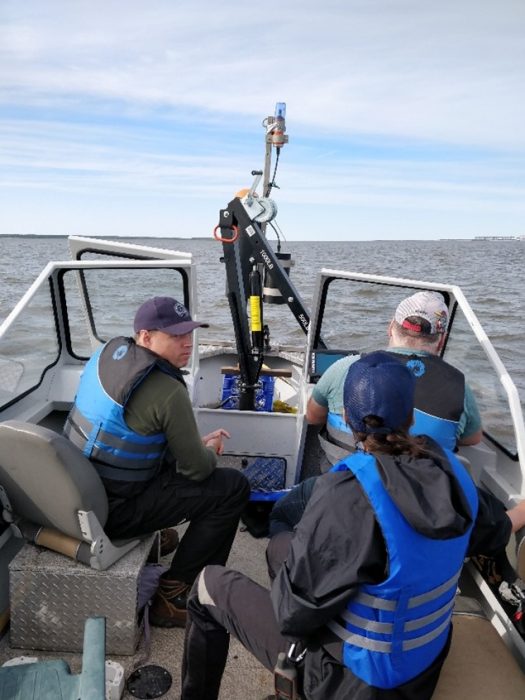
Time lapse photo of the first documented sighting of two bowhead whales in the Churchill River Estuary. Taken on July 17, 2020. Photo supplied by Emma Ausen and Veronica Coppolaro.
New paper out! First documented sighting of a group of bowhead whales in the Churchill River Estuary
A group of bowhead whales were sighted by researchers in the Churchill River Estuary.
In the summer of 2020, researchers from the University of Manitoba set up a time-lapse camera overlooking the Churchill River Estuary. The goal of their research was to understand the interactions between beluga whales and marine vessels. However, what they captured was unexpected — a group of bowhead whales, a phenomenon never before documented in the area.

Map of the Hudson Bay showing the Manitoba coast taken from Coppolaro et al. (2025).
The bowhead whale is the only baleen whale that lives year-round in the Arctic. Two populations are found in Canadian waters: The East Canada-Western Greenland (EC-WG) population, found in northern Hudson Bay to Greenland, and the Bering-Chukchi-Beaufort population, found in waters from northwestern Canada to Russia.
Commercial whaling from the 15th to the 19th century severely depleted the EC-WG population. While the population began to recover after commercial whaling ended in 1915, numbers recently seem to have plateaued.
A recently published paper by Coppolaro et al. highlights the first recorded sighting of a group of bowhead whales in the Churchill River Estuary and emphasizes the rarity of the occurrence based on historical data.
Veronica L.M. Coppolaro, Ph. D. candidate, and Emma Ausen, M.Sc., from the University of Manitoba, were conducting a beluga whale monitoring study when the sighting occurred. While reviewing time-lapse photos, Ausen noticed two dark figures in one of the images. Coppolaro recalls Ausen saying, “There’s a huge branch, like a log, in the water!”
Later, they heard reports from local tour guides of a bowhead whale in the estuary. “If the dates of the reports match the photos, we may have captured bowhead whales,” Ausen remarked. The pair then carefully identified the species in the images and worked to contextualize the observation. The goal of their paper was to determine how common such a sighting has been in the past and investigate why bowhead whales might be in the area.

Veronica Coppolaro, UM researcher, conducting a beluga whale monitoring study. Photo supplied by Veronica Coppolaro.
Apart from the summer migration of Western Hudson Bay belugas, no other whale species is known to frequent the Churchill River Estuary.
“The estuary is shallow, less than three meters in most parts of it,” Coppolaro explains. “And bowhead whales are big—up to 18 meters long!” Moreover, bowhead whales are typically observed alone when found outside their usual range. “They generally do not travel in groups,” Coppolaro emphasizes.
Given the rarity of this sighting, Coppolaro et al. conducted a review of bowhead whale sightings along the coast of Manitoba, compiling literature, anecdotal accounts, and observations from locals and researchers. They found only ten documented sightings of bowhead whales in the area since 1900, all of them involving single whales.

Time lapse camera set-up overlooking the Churchill River Estuary. Photo supplied by Emma Ausen and Veronica Coppolaro.
Why were the whales this far south?
One hypothesis is that the bowheads have moved south due to shifting habitats caused by climate change.
Another possibility is that the EC-WG population is increasing, leading to a gradual expansion of their range due to both climate change and population recovery.
Additionally, the decline in sea ice has led to more orca sightings in Hudson Bay. As a result, bowhead whales could be using the estuary as a refuge to escape predation.
“They could have also been scouting for food,” Coppolaro explains. Due to tidal changes, the estuary provides an abundance of food for both baleen and toothed whales.

Emma Ausen, UM Researcher, overlooking the estuary. Photo supplied by Emma Ausen and Veronica Coppolaro.
The whales could be using the warmer and shallower waters of the bay to molt and shed their skin, just like belugas do.
While there are many possible reasons for the bowheads’ presence in the estuary, one hypothesis is that the pair spotted in 2020 was a calf and a cow.
What does the future hold?
“Since 2000, there has been an increase in bowhead whale sightings in the estuary” Coppolaro explains. However, increased vessel traffic could impact the whales’ presence in the future.
The EC-WG population is designated as “Special Concern” by the Committee on the Status of Endangered Wildlife in Canada (COSEWIC). If the estuary becomes a hotspot for these whales, it may require additional management strategies. This could involve establishing limits on vessel size and speed in the estuary.

UM Researchers conducting fieldwork by boat in the Churchill River Estuary. Photo supplied by Emma Ausen and Veronica Coppolaro.
Coppolaro hopes that the findings of their paper will help raise awareness about shifting habitats and changes in marine ecosystems.
“There’s something special about when these animals come through—it’s big news in town, shared with everyone. It’s part of the wonder of Churchill and the adventure,” Ausen shares “Sometimes, science is simply about discovering more about the world we live in”.
You can read the full paper in Polar Biology by clicking the following link: First documented sighting of a group of bowhead whales outside their typical range in Hudson Bay | Polar Biology

Veronica Coppolaro (left) and Emma Ausen (right) in the field. Photo supplied by Emma Ausen and Veronica Coppolaro.

Beluga whales hanging around UM researchers’ boat. Photo supplied by Emma Ausen.






